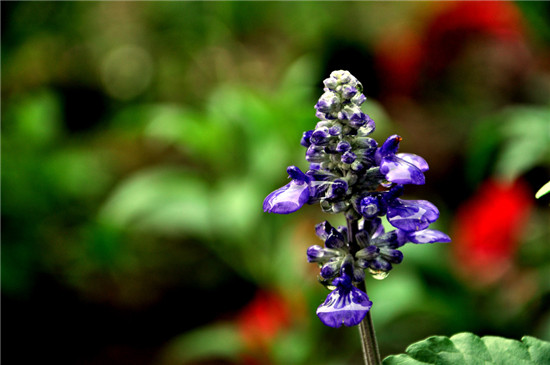Introduction of [blue sage] sage
Blue sage, also known as pink calyx sage, is 30-60 meters high and blossoms every summer. Next, let's take a look at this blue sage.

Blue sage, officially known as Calyx sage, leaf oval or lanceolate, blue-purple lip-shaped flowers, small upper lip, large lower lip and obvious white spots. It is actually a variety of sage, because of its romantic blue and purple colors, it is often mistaken for lavender when it blossoms in spring and summer. I always thought they were lavender at first, but I didn't know it until I carefully compared the pictures. The leaf surface of blue sage has concave and convex textures, wrinkles and grayish white. The pot cultivation of blue sage is suitable for the layout of flower beds, flower borders and garden attractions. It can also be dotted with rocks and gaps at the edge of the forest, showing solitude. Put the front of the natural building and the small courtyard, feel more elegant and quiet.
Sage leaves have antiseptic, antibacterial and anti-inflammatory effects. It's an aromatic plant. The plant is clumpy, pungent and full-bodied, which is extremely precious in medicinal vanilla and is known as "the vanilla of the poor". But for some reason, I didn't smell the fragrance.

Sage flower language: family concept, people who like this flower love family, with intellectual side; blue sage: rational; purple sage: wisdom.
Overall characteristics: perennial herbs, 30-60 cm high, tufted plants, pilose plants.
The characteristics of the stem: the stem is tetragonal columnar, and hairy, the lower part is slightly Lignified, showing a sub-low wood shape.
Leaf features: leaves to the growth of oval, 3-5 cm long gray-green, leaf surface has a concave-convex texture, and wrinkled, gray-white, pungent and rich fragrance.
Flower characteristics: with a long spike, about 12 meters long, small flowers, purple, large number of flowers, flowering in summer.
Temperature conditions: like warm, moist and sunny environment, strong cold resistance, afraid of heat, dry.
Soil conditions: it is suitable to grow in loose, fertile and well-drained sandy loam.
Region of origin: originally from southern North America.

Blue sage, also known as a string of blue. Native to southern North America. Like warm, moist and sunny environment. Strong cold resistance, afraid of hot, dry, suitable for loose, fertile and well-drained sandy loam or rotten leaf soil. The main method of propagation was sowing in spring, the optimum temperature for germination was 22-24 ℃, and germinated 20-25 days after sowing.
The seedlings need to be planted 1-2 times after sowing, and when the seedlings are high 15cm, they are planted in the 10cm basin and removed from the heart. Fertilize once every half month during the growing period to keep the basin soil moist. Phosphorus and potassium fertilizer was applied once before flowering, and inflorescence was removed after flowering, and still branches could continue to bloom. The seeds are not consistent in maturity and need to be picked while ripening.
The blue-purple lip shape of blue sage is very fresh and pleasing to the eye: potted plants are suitable for flower beds, flower borders and garden attractions. It can also be dotted with rocks and gaps at the edge of the forest, showing solitude. Put the front of the natural building and the small courtyard, feel more elegant and quiet.

The above is the whole content of the introduction of blue sage that I have summarized for you. I hope this article can help you. Please continue to follow us.
Related
- Wuhan Hospital Iron Tree Blooming Result Was Instantly Frightened by the Gardener Master
- Which variety of camellia is the most fragrant and best? Which one do you like best?
- What is the small blue coat, the breeding methods and matters needing attention of the succulent plant
- Dormancy time and maintenance management of succulent plants during dormancy
- Minas succulent how to raise, Minas succulent plant pictures
- What are the varieties of winter succulent plants
- How to raise succulent plants in twelve rolls? let's take a look at some experience of breeding twelve rolls.
- Attention should be paid to water control for succulent plants during dormant period (winter and summer)
- Watering experience of twelve rolls of succulent plants
- Techniques for fertilizing succulent plants. An article will let you know how to fertilize succulent plants.



